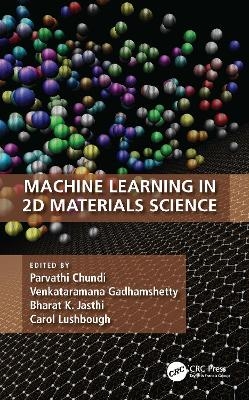
Machine Learning in 2D Materials Science
CRC Press (Verlag)
978-0-367-67820-3 (ISBN)
Data science and machine learning (ML) methods are increasingly being used to transform the way research is being conducted in materials science to enable new discoveries and design new materials. For any materials science researcher or student, it may be daunting to figure out if ML techniques are useful for them or, if so, which ones are applicable in their individual contexts, and how to study the effectiveness of these methods systematically.
KEY FEATURES
Provides broad coverage of data science and ML fundamentals to materials science researchers so that they can confidently leverage these techniques in their research projects
Offers introductory material in topics such as ML, data integration, and 2D materials
Provides in-depth coverage of current ML methods for validating 2D materials using both experimental and simulation data, researching and discovering new 2D materials, and enhancing ML methods with physical properties of materials
Discusses customized ML methods for 2D materials data and applications and high-throughput data acquisition
Describes several case studies illustrating how ML approaches are currently leading innovations in the discovery, development, manufacturing, and deployment of 2D materials needed for strengthening industrial products
Gives future trends in ML for 2D materials, explainable AI, and dealing with extremely large and small, diverse datasets
Aimed at materials science researchers, this book allows readers to quickly, yet thoroughly, learn the ML and AI concepts needed to ascertain the applicability of ML methods in their research.
Parvathi Chundi, PhD is Professor of Computer Science, University of Nebraska-Omaha. Prior to Omaha, Dr. Chundi was with Agilent Technologies and HP Labs, both in Palo Alto, CA. Venkataramana Gadhamshetty, PhD, PE is Professor of Environmental Engineering in Department of Civil and Environmental Engineering, South Dakota School of Mines and Technology. He is a cofounder of 2D materials for Biofilm Science Engineering and Technology (2DBEST) center and 2D materials laboratory (2DML) at SDSM&T. Bharat K. Jasthi, PhD is Associate Professor, Department of Materials and Metallurgical Engineering, South Dakota School of Mines and Technology. Dr. Jasthi has research expertise in the areas of microstructural modification, structure property correlation, new alloy development, powder metallurgy, additive manufacturing, and development of engineered surface thin films and coatings for a wide range of applications. Carol Lushbough, MA is an Emeritus Professor of Computer Science, University of South Dakota.
Chapter 1 Introduction to Machine Learning for Analyzing Material–Microbe Interactions
Venkataramana Gadhamshetty, Parvathi Chundi, and Bharat K. Jasthi
Chapter 2 Introduction to 2D Materials
Roberta Amendola and Amit Acharjee
Chapter 3 An Overview of Machine Learning
Dilanga Abeyrathna, Mahadevan Subramaniam, and Parvathi Chundi
Chapter 4 Discovery of 2D Materials with Machine Learning
Md Mahmudul Hasan, Rabbi Sikder, Bharat K. Jasthi, Etienne Z. Gnimpieba, and Venkataramana Gadhamshetty
Chapter 5 Bacterial Image Segmentation through Deep Learning Approach
Ejan Shakya and Pei-Chi Huang
Chapter 6 Self-Supervised Learning-Based Classification of Scanning Electron Microscope Images of Biofilms
Md Ashaduzzaman and Mahadevan Subramaniam
Chapter 7 Quorum Sensing Mechanisms, Biofilm Growth, and Microbial Corrosion Effects of Bacterial Species
Vaibhav Handa, Saurabh Dhiman, Kalimuthu Jawaharraj, Vincent Peta, Alain Bomgni, Etienne Z. Gnimpieba, and Venkataramana Gadhamshetty
Chapter 8 Data-Driven 2D Material Discovery Using Biofilm Data and Information Discovery System (Biofilm-DIDS)
Tuyen Do, Alain Bomgni, Shiva Aryal, Venkataramana Gadhamshetty, Diing D. M. Agany, Tim Hartman, Bichar D. Shrestha Gurung, Carol M. Lushbough, and Etienne Z. Gnimpieba
| Erscheinungsdatum | 15.11.2023 |
|---|---|
| Zusatzinfo | 11 Tables, black and white; 12 Line drawings, color; 3 Line drawings, black and white; 53 Halftones, color; 17 Halftones, black and white; 20 Illustrations, color; 65 Illustrations, black and white |
| Verlagsort | London |
| Sprache | englisch |
| Maße | 156 x 234 mm |
| Gewicht | 453 g |
| Themenwelt | Informatik ► Theorie / Studium ► Algorithmen |
| Informatik ► Theorie / Studium ► Künstliche Intelligenz / Robotik | |
| Technik ► Maschinenbau | |
| Technik ► Umwelttechnik / Biotechnologie | |
| ISBN-10 | 0-367-67820-9 / 0367678209 |
| ISBN-13 | 978-0-367-67820-3 / 9780367678203 |
| Zustand | Neuware |
| Haben Sie eine Frage zum Produkt? |
aus dem Bereich


